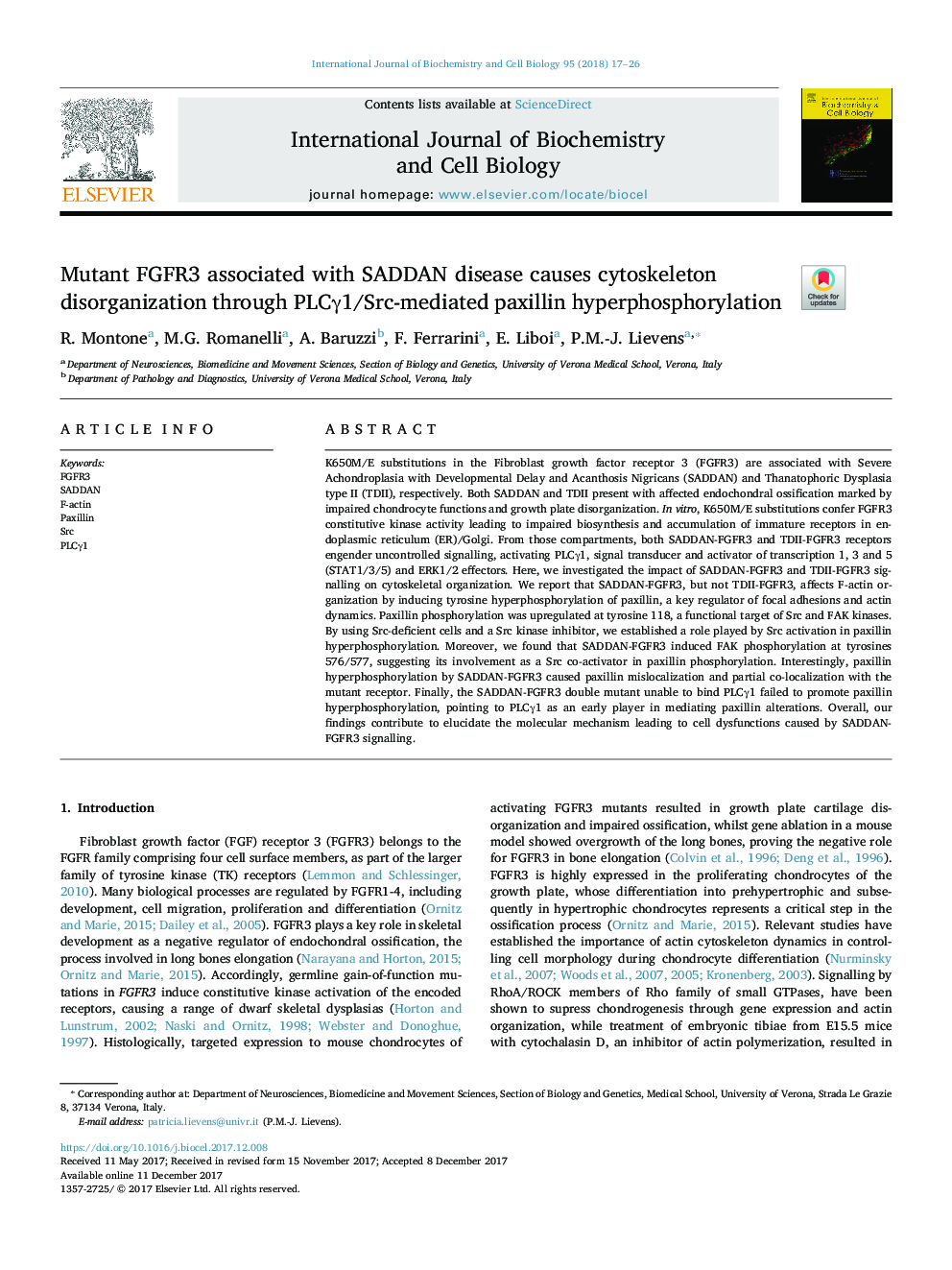| کد مقاله | کد نشریه | سال انتشار | مقاله انگلیسی | نسخه تمام متن |
|---|---|---|---|---|
| 8322072 | 1539846 | 2018 | 10 صفحه PDF | دانلود رایگان |
عنوان انگلیسی مقاله ISI
Mutant FGFR3 associated with SADDAN disease causes cytoskeleton disorganization through PLCγ1/Src-mediated paxillin hyperphosphorylation
دانلود مقاله + سفارش ترجمه
دانلود مقاله ISI انگلیسی
رایگان برای ایرانیان
موضوعات مرتبط
علوم زیستی و بیوفناوری
بیوشیمی، ژنتیک و زیست شناسی مولکولی
زیست شیمی
پیش نمایش صفحه اول مقاله

چکیده انگلیسی
K650M/E substitutions in the Fibroblast growth factor receptor 3 (FGFR3) are associated with Severe Achondroplasia with Developmental Delay and Acanthosis Nigricans (SADDAN) and Thanatophoric Dysplasia type II (TDII), respectively. Both SADDAN and TDII present with affected endochondral ossification marked by impaired chondrocyte functions and growth plate disorganization. In vitro, K650M/E substitutions confer FGFR3 constitutive kinase activity leading to impaired biosynthesis and accumulation of immature receptors in endoplasmic reticulum (ER)/Golgi. From those compartments, both SADDAN-FGFR3 and TDII-FGFR3 receptors engender uncontrolled signalling, activating PLCγ1, signal transducer and activator of transcription 1, 3 and 5 (STAT1/3/5) and ERK1/2 effectors. Here, we investigated the impact of SADDAN-FGFR3 and TDII-FGFR3 signalling on cytoskeletal organization. We report that SADDAN-FGFR3, but not TDII-FGFR3, affects F-actin organization by inducing tyrosine hyperphosphorylation of paxillin, a key regulator of focal adhesions and actin dynamics. Paxillin phosphorylation was upregulated at tyrosine 118, a functional target of Src and FAK kinases. By using Src-deficient cells and a Src kinase inhibitor, we established a role played by Src activation in paxillin hyperphosphorylation. Moreover, we found that SADDAN-FGFR3 induced FAK phosphorylation at tyrosines 576/577, suggesting its involvement as a Src co-activator in paxillin phosphorylation. Interestingly, paxillin hyperphosphorylation by SADDAN-FGFR3 caused paxillin mislocalization and partial co-localization with the mutant receptor. Finally, the SADDAN-FGFR3 double mutant unable to bind PLCγ1 failed to promote paxillin hyperphosphorylation, pointing to PLCγ1 as an early player in mediating paxillin alterations. Overall, our findings contribute to elucidate the molecular mechanism leading to cell dysfunctions caused by SADDAN-FGFR3 signalling.
ناشر
Database: Elsevier - ScienceDirect (ساینس دایرکت)
Journal: The International Journal of Biochemistry & Cell Biology - Volume 95, February 2018, Pages 17-26
Journal: The International Journal of Biochemistry & Cell Biology - Volume 95, February 2018, Pages 17-26
نویسندگان
R. Montone, M.G. Romanelli, A. Baruzzi, F. Ferrarini, E. Liboi, P.M.-J. Lievens,